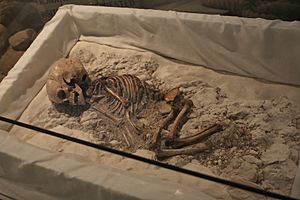Charlie (skeleton) facts for kids
Charlie is the name given to the skeleton of a three-year-old child. This very old skeleton is from the Neolithic period, also known as the New Stone Age. Charlie was found near the ancient stone circle of Avebury, in Wiltshire, England.
Archaeologists dug up Charlie's skeleton at Windmill Hill, Avebury in the 1920s. Today, you can see Charlie on display at the Alexander Keiller Museum in Avebury.
Contents
Who is Charlie the Skeleton?
Charlie is a special skeleton because it helps us learn about children from the Neolithic period. This was a time long ago when people started farming and building large stone monuments. Finding a child's skeleton from this era is quite rare. It gives clues about how people lived and died thousands of years ago.
Discovering Charlie's Past
Charlie's skeleton was found during important archaeological digs. These digs helped us understand more about the people who lived around the famous Avebury stone circle. Windmill Hill, where Charlie was found, is an ancient site. It was used by early farmers in Britain.
The Big Discussion About Charlie
There has been a lot of discussion about whether Charlie's skeleton should be on display. A group called the Council of British Druid Orders (CoBDO) believes Charlie should be reburied. They feel that putting a skeleton in a museum just for people to look at is not respectful. They asked for Charlie to be buried again close to where the skeleton was found.
Why Keeping Charlie on Display Matters
However, many archaeologists and historians disagree. They worry that reburying Charlie could set a bad example. They believe it might lead to other ancient human remains being reburied too. This would make it harder for scientists to study them. Keeping Charlie's skeleton in the museum allows experts to continue learning from it. It also lets the public see and understand more about our ancient past.
What Was Decided for Charlie?
To decide Charlie's future, two important organizations, English Heritage and The National Trust, asked the public for their opinions. They wanted to know what people thought should happen to Charlie. After listening to everyone, a decision was made in April 2010. It was decided that Charlie's skeleton would stay on public display at the museum. This way, both research and public education can continue.


